A Respite from the Heat: Rain and Cooler Temperatures Sweep Across Jammu and Kashmir
Srinagar: The scorching sun that has dominated Jammu and Kashmir (J&K) in recent weeks seems to be taking a temporary break. While Srinagar, the summer capital, did experience a slight rise in temperature on Monday, settling at 32.5°C, a welcome dip has been observed across much of the region. This shift in weather patterns brings the promise of cooler conditions and the potential for light rain showers in the coming days.
A Look at the Forecast: Rain Chances Rise
The Meteorological Department (MD) offers a glimmer of hope for those yearning for a respite from the heat. Dr. Mukhtar Ahmad, Director of the MD, predicts light rain showers happening at scattered locations across Jammu division and isolated places in Kashmir division until July 10th. This could be the beginning of a more significant change in the weather pattern.
More Rain on the Horizon?
The good news continues! Dr. Ahmad anticipates a period of light to moderate rain and thunderstorms across J&K from July 11th to 12th. This precipitation is expected to be scattered to fairly widespread in the Jammu division, with isolated to scattered showers in Kashmir. Even though the rain might not be continuous, it should help bring down the overall temperature and offer a refreshing change.
Current Conditions: A Mixed Bag
While the forecast suggests a cooler and wetter future, the current situation paints a slightly different picture. Despite the possibility of rain, temperatures across J&K remain relatively close to normal. Qazigund, the gateway to Kashmir, recorded a pleasant 31.6°C, while Pahalgam, the famed tourist destination, enjoyed a cool 27.1°C. Even higher-altitude areas like Kupwara experienced a moderate maximum temperature of 31.8°C.
Regional Variations: From Hill Stations to Plains
J&K’s diverse landscape offers a range of temperatures. Popular destinations like Kokernag and Gulmarg saw cooler conditions, with highs of 30.2°C and 22.2°C, respectively. Meanwhile, Jammu, the winter capital, saw a slightly higher temperature of 36.2°C, reflecting its lower altitude. Banihal recorded a moderate 32.0°C, while tourist hotspots like Batote, Katra, and Bhaderwah experienced a pleasant range between 28.4°C and 33.1°C.
An Alternative Perspective: A Look Beyond the Official Forecast
Independent weather forecaster Faizan Arif Keng offers a different take on the immediate future. He predicts that temperatures in J&K might remain slightly above normal, potentially rising by 3-4°C in the next few days. He also suggests that Srinagar could see highs close to 34°C. However, he agrees with the MD’s assessment that a full-blown heat wave is unlikely in the coming days.
Beyond the Headlines: The Importance of Weather Patterns
Understanding weather patterns is crucial for various reasons. Farmers rely on accurate forecasts to plan their crops and agricultural activities. Tourists often choose destinations based on the anticipated weather conditions. Additionally, weather patterns significantly impact our energy consumption, with cooler temperatures reducing reliance on air conditioning.
Environmental Considerations: The Link Between Climate and Weather
There’s a growing awareness of the link between climate change and weather patterns. While a shift towards cooler temperatures might offer temporary relief in J&K, the long-term trend suggests a potential rise in extreme weather events. It’s essential to be prepared for a future with more frequent heat waves, droughts, and unpredictable weather patterns.
A Call for Sustainable Practices: Mitigating Climate Change
The current weather shift highlights the importance of adopting sustainable practices in J&K. Embracing renewable energy sources like solar and wind power can reduce dependence on fossil fuels. Additionally, promoting water conservation and sustainable agriculture can help mitigate the impact of climate change.
Conclusion: A Welcome Change and a Look Towards the Future
The recent dip in temperatures and the possibility of rain showers offer a sigh of relief for residents of J&K. However, this is just a temporary reprieve. It’s crucial to understand the bigger picture and take steps to address climate change. By adopting sustainable practices and working towards a greener future, J&K can ensure a more stable and predictable climate for generations to come.




